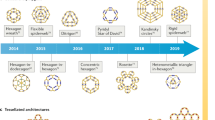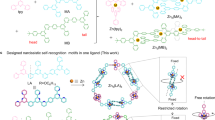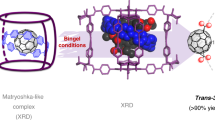Abstract
Metallosupramolecular chemistry relies on self-assembly processes in which complicated species form through labile dative-covalent interactions. Two remarkable areas of this chemistry are the synthesis of topologically complicated threaded assemblies and of three-dimensional (3D) polyhedral assemblies. Very few polyhedral 3D metallosupramolecular assemblies show threaded motifs within them. Here we report an example of a new type of threaded 3D metallosupramolecular assembly built from four organic ligands and four palladium ions, a Pd4L4 so-called ‘Solomon's cube’ in which interweaving and twisting of the ligands form both Solomon's links and figure-of-eight ring motifs. In the solid state, six of these Pd4L4 tetramers assemble into a hollow spheroid that closely resembles a stellated truncated hexahedron.
This is a preview of subscription content, access via your institution
Access options
Subscribe to this journal
Receive 12 print issues and online access
$259.00 per year
only $21.58 per issue
Buy this article
- Purchase on Springer Link
- Instant access to full article PDF
Prices may be subject to local taxes which are calculated during checkout



Similar content being viewed by others
References
Steed, J. W. & Atwood, J. L. Supramolecular Chemistry (Wiley, 2000).
Sauvage, J.-P. & Dietrich-Buchecker, C. Molecular Catenanes, Rotaxanes and Knots. A Journey Through the World of Molecular Topology (Wiley, 1999).
Pentecost, C. D. et al. A molecular Solomon link. Angew. Chem. Int. Ed. 46, 218–222 (2007).
Niergarten, J.-F., Dietrich-Buchecker, C. O. & Sauvage, J.-P. Synthesis of a doubly interlocked [2]-catenane. J. Am. Chem. Soc. 116, 375–376 (1994).
Ibukuro, F., Fujita, M., Yamaguchi, K. & Sauvage, J.-P. Quantitative and spontaneous formation of a doubly interlocking [2]catenane using copper(I) and palladium(II) as templating and assembling centers. J. Am. Chem. Soc. 121, 11014–11015 (1999).
McArdle, C. P., Vittal, J. J. & Puddephatt, R. J. Molecular topology: easy self-assembly of an organometallic doubly braided [2]catenane. Angew. Chem. Int. Ed. 39, 3819–3822 (2000).
Chichak, K. S. et al. Molecular Borromean rings. Science 304, 1308–1312 (2004).
Swiegers, G. F. & Malefetse, T. J. Classification of coordination polygons and polyhedra according to their mode of self-assembly. 2. Review of the literature. Coord. Chem. Rev. 225, 91–121 (2002).
Seidel, S. R. & Stang, P. J. High-symmetry coordination cages via self-assembly. Acc. Chem. Res. 35, 972–983 (2002).
Fujita, M. et al. Molecular paneling via coordination. Chem. Commun. 509–518 (2001).
Du, S. M., Stollar, B. D. & Seeman, N. C. A synthetic DNA molecule in three knotted topologies. J. Am. Chem. Soc. 117, 1194–1200 (1995).
Mao, C., Sun, W. & Seeman, N. C. Assembly of Borromean rings from DNA. Nature 386, 137–138 (1997).
Zhang, Y. & Seeman, N. C. Construction of a DNA truncated octahedron. J. Am. Chem. Soc. 116, 1661–1669 (1994).
Fujita, M., Fujita, N., Ogura, K. & Yamaguchi, K. Spontaneous assembly of ten components into two interlocked, identical coordination cages. Nature 400, 52–55 (1999).
Westcott, A., Fisher, J., Harding, L. P., Rizkallah, P. & Hardie, M. J. Self-assembly of a 3-D triply interlocked chiral [2]catenane. J. Am. Chem. Soc. 130, 2950–2951 (2008).
Wang, L., Vysotsky, M. O., Bogdan, A., Bolte, M. & Bohmer, V. Multiple catenanes derived from calix[4]arenes. Science 304, 1312–1314 (2004).
Wikoff, W. R. et al. Topologically linked protein rings in the Bacteriophage HK97 capsid. Science 289, 2129–2133 (2000).
Collet, A. Cyclotriveratrylenes and cryptophanes. Tetrahedron 43, 5725–5759 (1987).
Huerta, E., Cequier, E. & de Mendoza, J. Preferential separation of fullerene[84] from fullerene mixtures by encapsulation. Chem. Commun. 5016–5018 (2007).
Dam, H. H., Reinhoudt, D. N. & Verboom, W. Influence of the platform in multicoordinate ligands for actinide partitioning. New J. Chem. 31, 1620–1632 (2007).
Zhang, S. & Echegoyen, L. Selective anion sensing by a tris-amide CTV derivative: 1H NMR titration, self-assembled monolayers, and impedance spectroscopy. J. Am. Chem. Soc. 127, 2006–2011 (2005).
Gawenis, J. A., Holman, K. T., Atwood, J. L. & Jurisson, S. S. Extraction of pertechnetate and perrhenate from water with deep-cavity [CpFe(arene)]+-derivatized cyclotriveratrylenes. Inorg. Chem. 41, 6028–6031 (2002).
Bardelang, D., Camerel, F., Ziessel, R., Schmutz, M. & Hannon, M. J. New organogelators based on cyclotriveratrylene platforms bearing 2-dimethylacetal-5-carbonylpyridine fragments. J. Mater. Chem. 18, 489–494 (2008).
Zhong, Z., Ikeda, A., Shinkai, S., Sakamoto, S. & Yamaguchi, K. Creation of novel chiral cryptophanes by a self-assembling method utilizing a pyridyl–Pd(II) interaction. Org. Lett. 3, 1085–1087 (2001).
Carruthers, C. et. al. The dimeric ‘hand-shake’ motif in complexes and metallo-supramolecular assemblies of cyclotriveratrylene-based ligands. Chem. Eur. J. 14, 10286–10296 (2008).
Ronson, T. K., Fisher, J., Harding, L. P. & Hardie, M. J. Star-burst prisms with cyclotriveratrylene-type ligands: a [Pd6L8]12+ stella octangula. Angew. Chem. Int. Ed. 46, 9086–9088 (2007).
Sumby, C. J. & Hardie, M. J. Capsules and star-burst polyhedra: an Ag2L2 capsule and tetrahedral Ag4L4 metallo-supramolecular prism with cyclotriveratrylene-type ligands. Angew. Chem. Int. Ed. 44, 6395–6399 (2005).
Xu, D. & Warmuth, R. Edge-directed dynamic covalent synthesis of a chiral nanocube. J. Am. Chem. Soc. 130, 7520–7521 (2008).
Constable, E. C., Housecroft, C. E., Neuburger, M., Reymann, S. & Schaffner, S. Self-assembly of a novel pentanuclear centred-tetrahedral silver species. Chem. Commun. 1056–1057 (2004).
Allouche, L., Marquis, A. & Lehn, J.-M. Discrimination of metallo supramolecular architectures in solution by using diffusion ordered spectroscopy (DOSY) experiments: double-stranded helicates of different lengths. Chem. Eur. J. 12, 7520–7525 (2006).
Megyes, T. et al. X-ray diffraction and DOSY NMR characterization of self-assembled supramolecular metallocyclic species in solution. J. Am. Chem. Soc. 127, 10731–10738 (2005).
Adams, C. C. The Knot Book. An Elementary Introduction to the Mathematical Theory of Knots (W. H. Freeman, 1994).
Herges, R. Topology in chemistry: designing Möbius molecules. Chem. Rev. 106, 4820–4842 (2006).
Orr, G. W., Barbour, L. J. & Atwood, J. L. Controlling molecular self-organization: formation of nanometer-scale spheres and tubules. Science 285, 1049–1052 (1999).
Atwood, J. L. et al. Towards mimicking viral geometry with metal–organic systems. J. Am. Chem. Soc. 126, 13170–13171 (2004).
McKinlay, R. M., Cave, G. W. V. & Atwood, J. L. Supramolecular blueprint approach to metal-coordinated capsules. Proc. Natl Acad. Sci. USA 102, 5944–5948 (2005).
Childs, L. J., Alcock, N. W. & Hannon, M. J. Assembly of a nanoscale chiral ball through supramolecular aggregation of bowl-shaped triangular helicates. Angew. Chem. Int. Ed. 41, 4244–4247 (2002).
Vazquez, M. et al. Non-covalent aggregation of discrete metallo-supramolecular helicates into higher assemblies by aromatic pathways: structural and chemical studies of new aniline-based neutral metal(II) dihelicates. Eur. J. Inorg. Chem. 3479–3490 (2005).
Pascu, M., Clarkson, G. J., Kariuki, B. M. & Hannon, M. J. Aggregation of imine-based metallo-supramolecular architectures through π–π interactions. Dalton Trans. 2635–2642 (2006).
Lavalette, A., Tuna, F., Clarkson, G., Alcock, N. W. & Hannon, M. J. Aggregation of metallo-supramolecular architectures by metallo-assembled hydrogen bonding sites. Chem. Commun. 2666–2667 (2003).
Vazquez, M. et al. A 3D network of helicates fully assembled by π-stacking interactions. Chem. Commun. 1840–1841 (2003).
Breuning, E., Ziener, U., Lehn, J.-M., Wegelius, E. & Rissanen, K. Two-level self-organisation of arrays of [2 × 2] grid-type tetranuclear metal complexes by hydrogen bonding. Eur. J. Inorg. Chem. 1515–1521 (2001).
Ziessel, R. Schiff-based bipyridine ligands. Unusual coordination features and mesomorphic behaviour. Coord. Chem. Rev. 216, 195–223 (2001).
Sheldrick, G. M. SHELXS-97 (Univ. Göttingen, 1990).
Sheldrick, G. M. SHELXL-97 (Univ. Göttingen, 1997).
Spek, A. & van der Sluis, P. BYPASS: an effective method for the refinement of crystal structures containing disordered solvent regions. Acta Crystallogr. A 46, 194–201 (1990).
Acknowledgements
We thank the EPSRC for funding this research, STFC Daresbury laboratory for access to microdiffraction facilities and I. Blakeley for microanalysis.
Author information
Authors and Affiliations
Contributions
T.K.R. performed most experiments, interpreted results and co-wrote the paper. J.F. performed and interpreted 2D, diffusion and variable temperature NMR experiments. L.P.H. performed MS experiments. P.J.R. and J.E.W. maintained synchrotron facilities and assisted in data treatment. M.J.H. interpreted the results and wrote the paper.
Corresponding author
Supplementary information
Supplementary information
Supplementary information (PDF 1176 kb)
Supplementary information
Crystallographic data for complex 2 (CIF 34 kb)
Rights and permissions
About this article
Cite this article
Ronson, T., Fisher, J., Harding, L. et al. Stellated polyhedral assembly of a topologically complicated Pd4L4 ‘Solomon cube’. Nature Chem 1, 212–216 (2009). https://doi.org/10.1038/nchem.213
Received:
Accepted:
Published:
Issue Date:
DOI: https://doi.org/10.1038/nchem.213
This article is cited by
-
Polar Solomon rings in ferroelectric nanocrystals
Nature Communications (2023)
-
A self-complementary macrocycle by a dual interaction system
Nature Communications (2022)
-
Supramolecular Kandinsky circles with high antibacterial activity
Nature Communications (2018)
-
Self-assembly of polycyclic supramolecules using linear metal-organic ligands
Nature Communications (2018)
-
A Cobalt Supramolecular Triple-Stranded Helicate-based Discrete Molecular Cage
Scientific Reports (2017)



